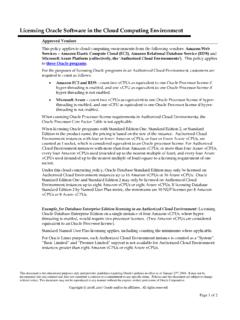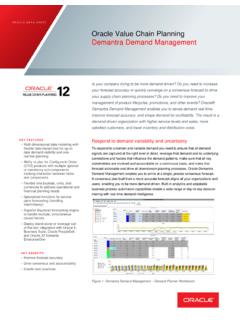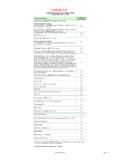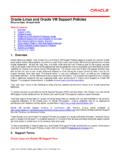Transcription of Oracle Forms Services 10g Advanced Configurations
1 Oracle Forms Services 10g Advanced Configurations An Oracle White Paper December 2006 Oracle Forms Services 10g Advanced Configurations Page 2 Oracle Forms Services 10g Advanced Configurations Introduction ..3 Customizing the Forms request Aliasing the Forms Servlet and Forms Listener Deploying Forms in a custom OC4J Using Oracle Forms restricted URL Accessing Forms via a Reverse Running Forms with the HTTP Server on a separate Load Balancing Oracle Forms Running Oracle Forms Services over Oracle Forms Services 10g Advanced Configurations Page 3 Oracle Forms Services 10g Advanced Configurations INTRODUCTION With the installation of Oracle Application Server 10g.
2 Oracle Forms Services 10g and Oracle Reports Services 10g are automatically installed and configured for you to immediately deploy your Oracle Forms applications to the web. Oracle Forms Services has all its server and application specific settings configured in the and configuration files, which are located in the forms90/server directory of the Oracle Application Server middle tier home. You use the file to create specialized application Configurations to shortcut the Forms Services request URL. A typical Forms request URL for Oracle Forms 10g ( ) looks like http://server:port/forms90/f90servlet?
3 Config=appconf¶meter= Though there is nothing wrong in using the default configuration of Oracle Forms Services in a production environment, customizing the Forms configuration improves the Oracle Forms Services deployment platform and can provide additional security. An example for using optimized custom Forms Services configuration is a reverse proxy that handles incoming Forms Services requests on an external HTTP Server located in the demilitarized zone, hiding the internal production server name and IP address from the outside world. 1 Oracle Forms Services 10g ( ) no longer has the version number within its virtual path and servlet name This whitepaper covers Advanced Configurations for the Oracle Forms Services 10g ( ) and Oracle Forms Services 10g R2 release ( ).
4 Note that Oracle Forms Services no longer has the version digit in its configuration files and URL names. Oracle Forms Services 10g Advanced Configurations Page 4 Figure 1: Proxy server architectural diagram A second example where customizing the default Forms Services configuration becomes useful is when Oracle Forms Services applications need to be integrated with a J2EE architecture to enable Oracle Forms applications and J2EE applications to coexist and integrate in the same server architecture. The following sections explain Advanced Oracle Forms Services configuration settings.
5 CUSTOMIZING THE Forms REQUEST URL As mentioned earlier in this paper, the default Forms Services web request URL has the format of http(s)://server:port/forms90/f90servlet (or http(s)://server:port/ Forms /frmservlet in Forms 10g Release 2 ( )) Some enterprises use uniform URL patterns with their web deployed applications that, for example, include the name of the application. Such uniform URL patterns can be used for cosmetic reasons or for providing a more meaningful URL to application users. One option to perform Oracle Forms URL customization is to use URL rewriting by leveraging the Oracle HTTP Server Redirect and Rewrite directives.
6 In this configuration , your Forms application request URL is hidden from the application user. This approach is also recommended to integrate older Oracle Forms Services releases that are hosted on older versions of Oracle Application Server, with a newer version of Oracle Application Server acting as the front HTTP server. Another option to customize your Forms Application request URLs is to change the Oracle Forms Services virtual path name and Oracle Forms Servlet name. You can change the default Forms Services request URL as follows: Oracle Forms Services 10g Advanced Configurations Page 5 1.
7 Define an alias name for the Forms Servlet (f90servlet/frmservlet) as described in the Oracle Forms Services deployment guide, a part of the Oracle Application Server documentation library. For example, changing the Forms Services Servlet name f90servlet/frmservlet to myservlet changes the Oracle Forms Services request URL to http://machine:port/forms90/myservlet or (http://machine:port/ Forms /myservlet) Defining a Forms Servlet alias for the f90servlet/frmservlet is discussed in the section titled Aliasing the Forms Servlet and Forms Listener Servlet.
8 2. Setup a custom OC4J container instance to deploy the Oracle Forms Services libraries to a different J2EE context root. This allows the Forms Services URL to be changed from http://server:port /forms90/f90servlet or (http://server:port/ Forms /frmservlet ) to http://server:port/myvirtual_directory /f90servlet or (http://server:port/myvirtual_directory/ frmservlet). This configuration is discussed in the section Deploying Forms in a Custom OC4J Container . Aliasing the Forms Servlet and Forms Listener Servlet There are beneficial reasons for defining an alias name for the Forms Services Servlet.
9 To customize the Forms Services request URL To use separate file for different applications To define different Servlet initialization parameters To comply with any security policies for your application, computer, or enterprise Oracle Forms Services 10g Advanced Configurations Page 6 Alias names for the Oracle Forms Services Servlet and the Oracle Forms Services Listener Servlet are defined in the deployment descriptor file of the Oracle Forms installation. The deployment file is a standard J2EE configuration file that you edit with any text editor.
10 The default Oracle Forms Services installation deploys the Forms Servlet and the Forms Listener Servlet to the OC4J_BI_FORMS directory of the Oracle Application Server 10g middle tier installation. The deployment file is located in the J2EE\OC4J_BI_Forms\applications\forms90a pp\forms90web\WEB-INF Or (J2EE\OC4J_BI_Forms\applications\formsap p\formsweb\WEB-INF in Forms 10g Release 2 ( )) sub-directory of the Oracle Application Server middle tier installation. The new Forms Servlet alias name is defined below the <web-app> element using the <servlet> and <servlet-mapping> elements.













